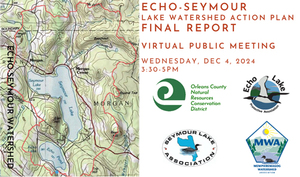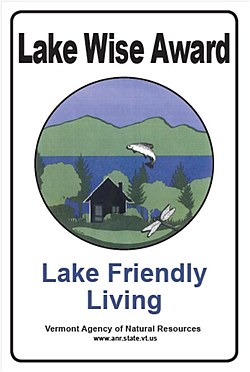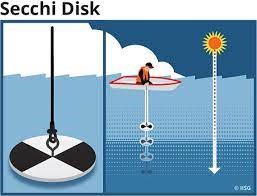Echo Lake is considered to have one of the highest water qualities in Vermont. Currently, Echo Lake is free of aquatic invasive plants. Water quality is where the majority of ELPA’s resources, financial and people power are focused.
Our goal is to maintain Echo Lake free from invasive species, and to not only maintain water quality, but enhance it. To that end there are several activities the association undertakes to achieve the goals: Access Greeter Program, Vermont Invasive Patroller Program, Water Quality Control, Lake Wise.
Volunteers Needed!
These Programs could not be successful without amazing volunteers. If you can, please consider volunteering and helping us keep Echo Lake as pristine as possible.
Contact:
The purpose of the Vermont Boat Access Greeter Program is to prevent the spread of Aquatic Invasive Species (AIS). An invasive species is nearly impossible to eradicate once introduced, so early detection and spread prevention by citizen monitoring efforts are critically important.
VERMONT INVASIVE PATROLLER PROGRAM
The Watershed Management Division of the Vermont Department of Environmental Conservation (DEC) promotes the Vermont Invasive Patroller Program, which relies on volunteers to monitor water bodies for new introductions of invasive species, and report their findings to the DEC.
VERMONT LAY MONITORING PROGRAM
This is a citizen participation program in which volunteers are trained and equipped to conduct periodic water quality sampling on lakes
The Lake Wise Program is an Agency of Natural Resources initiative that awards lake-friendly shoreland property owners. The goal of Lake Wise is to establish a new normal, a new culture of lakeshore landscaping that is proven to help protect the lake.
For more information, see The Vermont Shoreland Protection Act on ==> Resources.
A public hearing for Echo Lake’s petition to prohibit wake boats and wake sport activities has been scheduled for December 10th, starting at 4:00 p.m. at the Gateway Center, 84 Fyfe Drive, Newport, VT. The hearing will be a hybrid meeting, so you may attend in person or virtually.
Here’s a link to our petition: https://dec.vermont.gov/sites/dec/files/wsm/lakes/VUPW/WakeBoatPetition(Echo-Lake).pdf
It’s imperative that your voice is heard! We need our members to show up!
If you can, attend in person. If not, please attend virtually. We are asking everyone to send a letter of support. The Agency of Natural Resources needs to know that our community supports this petition.
Send your written comments to anr.wsmdlakes@vermont.gov. The subject line should include “Wakesports—Echo Lake. ” The deadline for the written comments is December 23rd.
There will be an opportunity to speak at the public hearing. The sign-up to speak will open two weeks prior to the hearing. The number of speakers will be limited, but there is no limit to the number of written comments that can be submitted.
The Department of Environmental Conservation needs to hear your voices! Start on those letters now and get them in before the hustle and bustle of the holidays takes over.
Below is more information about the public hearing. If you have questions, please email Holly at EchoWaterQuality@gmail.com
Thank you for supporting and helping to protect our beloved Echo Lake.
Your ELPA Board
In accordance with the “procedure for evaluating petitions to adopt, amend or repeal surface water and wetland rules,” the Lakes and Ponds program will hold at least one public meeting to foster public participation in the petition process prior to determining whether or not to initiate formal rulemaking. The public meetings will be divided into two to initiate public engagement for multiple petitions. The announcement for these public meetings opens up the public comment period to review all eight petitions.
WHAT: A public meeting to receive comments on five petitions proposing amendments for lake-specific changes to the Use of Public Waters Rules governing wakesports on Great and Little Averill Lakes, Echo Lake in Charleston, Lake Parker (Glover), Shadow Lake (Glover), and Lake Willoughby.
WHERE: The Gateway Center 84 Fyfe Dr., Newport, VT 05855
OR
Online via Microsoft Teams, using the link at the meeting time: Join the meeting now
Meeting ID: 271 524 703 497
Passcode: jhv7DQ
OR: Dial in by phone
+1 802-828-7667,,934454274#
WHEN: December 10, 2024, from 4:00 pm to 8:00 pm
To submit a comment:
Written and verbal comments will be accepted.
- Please submit written comments to anr.wsmdlakes@vermont.gov . Public comments will be accepted until 4:30 p.m. on December 23rd. IMPORTANT: when submitting a public comment, please include the word “wakesports” in the subject line AND the specific petition (lake) for which you are providing a comment.
- Registration to provide verbal comments at the public meeting will be available here two weeks prior to the meeting.
Equal weight is given to comments made in person, virtually, or in writing.
Draft Meeting Agenda (Approximate Timing)
Meeting outline: 10-minute DEC intro followed by a 10-minute petitioner overview of their petition and 30-minutes of public comments. Repeat until all petitions have had public comments.
- 4:00: DEC intro to the petition process and meeting purpose
- 4:15: Averill Lakes petitioner overview
- 4:25: Averill Lakes petition comments
- 5:00: Echo Lake petitioner overview
- 5:10: Echo Lake petition comments
- 5:45: Lake Parker petitioner overview
- 5:55: Lake Parker petition comments
- 6:30: Shadow Lake petitioner overview
- 6:40: Shadow Lake petition comments
- 7:15: Lake Willoughby petitioner overview
- 7:25: Lake Willoughby petition comments
- 8:00 Wrap-up
Copies of the petitions, along with any updates and pertinent information, will be available at the following link: https://dec.vermont.gov/watershed/lakes-ponds/lakes-and-ponds-rulemaking
Thank you for your input and participation.
If you have specific questions about the meeting, please reach out to anr.wsmdLakes@vermont.gov
Vermont Agency of Natural Resources | Department of Environmental Conservation
Watershed Management Division, Lakes and Ponds Program
1 National Life Drive, Montpelier, VT 05620-3522
Phone: 802-490-6133
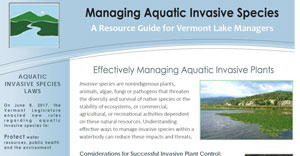
Echo Lake Protective Association’s AIS (Plant) Rapid Response Plan
One of the principal missions of the Echo Lake Protective Association (ELPA) is to preserve and protect the healthy ecology of the lake by preventing the introduction of non-native aquatic invasive species (AIS). If introduced, it seeks their eradication. To achieve these objectives, the ELPA has established a Rapid Response Plan for AIS (plants).
This Rapid Response Plan is in place to protect the health of Echo Lake. It seeks to contain and control the spread of AIS by implementing best management practices with the intent of achieving complete control and eradication. In full compliance with Vermont state regulatory requirements, the Plan will employ an objective management approach in evaluating how best to control each AIS site discovered, with the least interference with lake activities.
Once the plant has been sent to the State for identification and confirmation that it is an Aquatic Invasive Species the following actions will be taken by ELPA:
If the location of the plant is unknown, ELPA Vermont Invasive Patrollers will immediately conduct lakebed surveys to determine the area of infestation.
If the plant’s location can be determined or has been determined, then:
Additional information will be gathered and shared with the State which will include (if possible and applicable):
The exact location and size of the infested area.
A measurement of the lake depth, water current, and sunlight penetration level.
An estimate of the chances of dispersal (heavy traffic area, vulnerable to wind currents).
Assess the possible impediment to recreation accessibility.
The next actions to be taken:
Collaborate with the Echo Lake Protective Association’s Board of Directors and the Department of Environmental Conservation to initiate and maintain an effective lake management plan. Timely updates will be provided to ELPA’s Board of Directors on the status of the infestation and the proposed next steps needed for eradication.
Mobilize a rapid response team of volunteer ELPA’s Vermont Invasive Patrollers (VIPs) to contain the invasive species infestation, marking the site by placing orange buoys at the lake surface for lake users to avoid recreation near that site to minimize water disturbance and prevent further plant spread.
VIPs will monitor the area and report any changes or concerns to the Lakebed Survey Coordinator.
Encourage shoreline property owners to regularly monitor their waterfronts for the identified AIS plant or any unusual underwater plant growth and immediately report it to the Lakebed Survey Coordinator.
Provide educational outreach to Association members and lake users on the non-native AIS infestation and the dangers it poses to Echo Lake through email blasts, ELPA’s Facebook page, and on the ELPA website.
Containment and eradication methods to be deployed by the Echo Lake Protective Association (in order of prescription):
All methods will have prior approval by the ELPA Board of Directors. If any method other than hand pulling is used, then a permit must be obtained from the Department of Environmental Conservation.
Further information can be found at: https://dec.vermont.gov/sites/dec/files/wsm/lakes/ans/docs/Managing%20Aquatic%20Invasive%20Species%202018.pdf
Hand Pulling: Best for widely scattered plants (less than 500 stems per acre). It is a highly selective plant removal method. Effective control for small areas and prevents reinfestation. Labor intensive but can be done by trained volunteers.
Benthic Barriers: Non-selective, impacts all plants, and may impact macroinvertebrates and other nontarget organisms. Barriers require routine, annual maintenance, installation & removal, but can be reused. Labor intensive during installation and removal. The approximate cost is $400.00 for each 8 ft. x 100 ft. Mat.
Diver-Assisted Suction Harvesting (DASH): Best for small to moderate infestations (less than 1 acre in size). Skilled staff and technical equipment are required for this method. More efficient than hand pulling for higher plant densities. Cost per acre is $25,000 – $50,000 per acre.
Mechanical Harvesting (“mowing the weeds”): These are large barges that cut the AIS at or below the water surface. This is good for larger, dense areas. This method risks fragments to be released where they can be transplanted. Cost is $500-2,500 per acre.
ELPA’s Additional Preventive Work:
Purchase and maintain all equipment necessary to operate the control program.
Procure or design educational materials and distribute, as necessary.
Provide the most updated information to the Echo Lake Protective Association’s Facebook page and website.
Apply for grants for State and Town funding, and for any necessary State environmental permits to strengthen our control program.
Network with knowledgeable experts for technical advice to help ELPA prevent and defend against additional infestations of aquatic invasive species or other emerging environmental issues.
Attend relevant seminars and workshops.
The Echo Lake Protective Association would like to thank the Shadow Lake Association for sharing their procedures, information, and experience. Their help in developing this plan has been invaluable.
July 2023
I am writing to update you on the status of the Echo Lake reclassification petition and on our broader initiative to advance the reclassification of lakes and streams statewide and to establish a more comprehensive and site-specific suite of protections for Class A(1) and B(1) waters through proposed statutory changes and the Agency of Natural Resources proposed Antidegradation Implementation Rule.
As you know, we decided to pause the petition review process for the four pending lake reclassification petitions so the Agency could work toward a more comprehensive protection solution. This solution would allow reclassification determinations to be based solely upon water quality data and not whether the current statutory prohibition on new indirect systems with a design flow of 1,000 gallons or greater in new Class A waters is appropriate. While we didn’t make it to the finish line with this initiative during the 2023 legislative session, we did make significant progress with the passage of a Senate bill (S.146) relating to the permitting of indirect discharges, antidegradation, and reclassification.
We greatly appreciate your investment of time and effort to prepare the reclassification petition and we share your goal of protecting the existing excellent water quality in Echo Lake. To that end, we ask for your continued patience as we work to advance our broader efforts to provide a better suite of protections for our highest quality surface waters, like Echo Lake, than reclassification alone.
We will return to the statehouse to continue advancing this initiative in the legislature during the 2024 session. We are also considering holding meetings later this summer to discuss the Agency’s overall effort to advance reclassification through statutory changes and the proposed antidegradation rule and will share the meeting dates and times as soon as they are scheduled. We look forward to further discussing with you how this work would advance water quality protections for Echo Lake and Vermont surface waters more broadly.
Please reach out if you have any questions and we will be in touch again soon.
Sincerely,
John Beling
The raw data from the tributary testing done over the summer was sent to ELPA at the end of September. Echo Lake was tested for both Chloride (which is usually found in road salt) and Phosphorus (nutrient loading). Our Watershed Manager, Ben Copans has looked over the data and made a few observations. Chloride levels were consistently low in all tested tributaries. As far as Phosphorus, Dickie Brook’s levels were higher in the spring than during the rest of the testing period. Bennett Brook’s levels increased over the summer. Cold Spring Brook, which flows off Winape Hills, had higher levels in the spring and at the end of summer. The Inlet’s Phosphorus levels were consistently low, which reflects Seymour Lake’s Phosphorus levels. Phosphorus levels are usually higher in the spring or during periods of high rainfall. While none of the results were out of the ordinary there were spikes (a sudden or extreme increase) in several of Cold Spring Brook’s and Bennett Brook’s samples, which may need to be addressed. More than likely ELPA will request a second year of LaRosa testing to get a more accurate picture of our tributaries. This winter a more formal analysis will be done by the LaRosa Partnership Program in which they will be developing a reporting platform to display and interpret the results. Information on these will be in the ELPA spring newsletter and will be posted on the ELPA website.
ELPA and The LaRosa Partnership Program
It’s called The LaRosa Volunteer Water Quality Monitoring Analytical Services Partnership, or more commonly known as the LaRosa Partnership Program.
Since 2003, this program has helped watershed organizations and monitoring groups across Vermont implement new and/or ongoing monitoring projects for surface waters in need of water quality assessment by helping to alleviate the financial burden of laboratory analysis costs.
This testing allows community members to engage with their local streams and rivers firsthand, learn about water quality issues, and use water testing to identify where impacts are present. Due to Echo Lake’s rising phosphorus levels, it clearly was advantageous for ELPA to apply for one of these grants.
In 2021, the Echo Lake Protective Association applied for and was awarded a LaRosa grant to test four streams flowing into Echo Lake. These streams included Bennett Brook, Dickie Brook, Cold Spring Brook, and the Inlet. There were 10 samples taken at each site over the period from June to August 2021. Two of these samples included high flow events (periods of heavy rain).
Echo Lake’s tributaries were tested for Chloride and Phosphorus. Chloride comes from de-icing road salt, water softening, dust suppressant, fertilizer, and manure that gets into lakes and streams through groundwater. While Phosphorus is an essential element for plant life, too much of it in a waterbody can speed up eutrophication (a reduction in dissolved oxygen in water bodies caused by an increase of mineral and organic nutrients) of a lake. High levels of phosphorus can also lead to algae blooms that produce algal toxins which can be harmful to human and animal health. Phosphorus enters a lake through non-point sources of pollution such as road, lawn fertilizer, agricultural, and stormwater runoff, along with poorly operating septic systems.
Articles on the testing process and observational results are in the 2021 spring and fall newsletters, which can be accessed on this website under “About ELPA” in the menu.
A formal review of the results will be released over the winter and will be added once received.
Echo Lake is proud to be the first recipient of the Vermont Gold Lake Wise Award.
Lake Wise is an education and outreach program funded by Vermont’s Agency of Natural Resources that rewards lakefront homeowners who manage their land to protect water quality and habitat and assists those who are working towards that goal. The program is free, non-regulatory, and voluntary. Homeowners receive individualized suggestions for adopting Lake Wise practices to prevent the threat to Echo’s water quality caused by heavy rains or snow melt thereby keeping runoff and pollutants from stormwater out of lake waters. Properties that protect the lake and meet Lake Wisestandards earn the coveted Lake Wise Award, consisting of a distinctive sign that can be posted on their property. The sign identifies the homes of good stewards and demonstrates what lake-friendly living looks like.
Property owners not yet meeting the Lake Wise standards receive recommendations for what they can do to reduce erosion and protect their lake. Whether it’s installing a dripline trench around a structure, reducing lawn size and maintenance, adding more plants to a shoreline buffer, using infiltration steps, or meandering pathways, and other best management practices to slow the flow, there is always something landowners can do to reduce their impact on Echo. Here is a link to Best Management Practices:
https://dec.vermont.gov/watershed/lakes-ponds/lakeshores-lake-wise/bmp
Echo Lake is proud to be the first recipient of the Gold Lake Wise Award, presented to lakes that have a minimum of 15% of shoreland owners receiving the Lake Wise Award. Only 3 lakes have obtained this recognition. Echo Lake’s shoreland owners have continued to manage their properties to meet the Lake Wise standard with more than 60% of its frontage classified as Lake Wise, the most of any lake in Vermont.
For more information on Lake Wise visit :
https://dec.vermont.gov/watershed/lakes-ponds/lakeshores-lake-wise/what
Why is it important to have a lake friendly property?
Recent Vermont lake science from the National Lake Assessment conducted by the EPA shows that Vermont ranked lowest in the northeast ecoregion and in the nation for degraded shoreland disturbance. Shoreland disturbance can be directly related to degraded water quality and aquatic habitat.
Most importantly, Echo Lake’s phosphorus levels are rising at an alarming rate. Phosphorus is a naturally occurring element that feeds lake algae, a healthy part of any lake ecosystem. But too much phosphorus can put a lake out of balance, feeding massive algae blooms that smell terrible, turn water green, degrade wildlife habitat, and potentially harm human and pet health.
You can find phosphorus in lots of places – pet waste, fertilizers, household cleaners, motor oil – none of which should ever find their way into a lake. But the biggest source of phosphorus is sand and soil that is washed into a lake after a rain event. Thus, we need everyone to pitch in and help protect the beauty of our lake by maintaining a shoreline that helps prevent pollutants from entering our beautiful lake.
If you would like information about how to the make your property lake friendly, email: echolakewise@gmail.com
Echo Lake’s first recipients, John and Carolyn Simsarian, received the lake Wise Award from Amy Picotte Vt Department of Environmental Conservation.
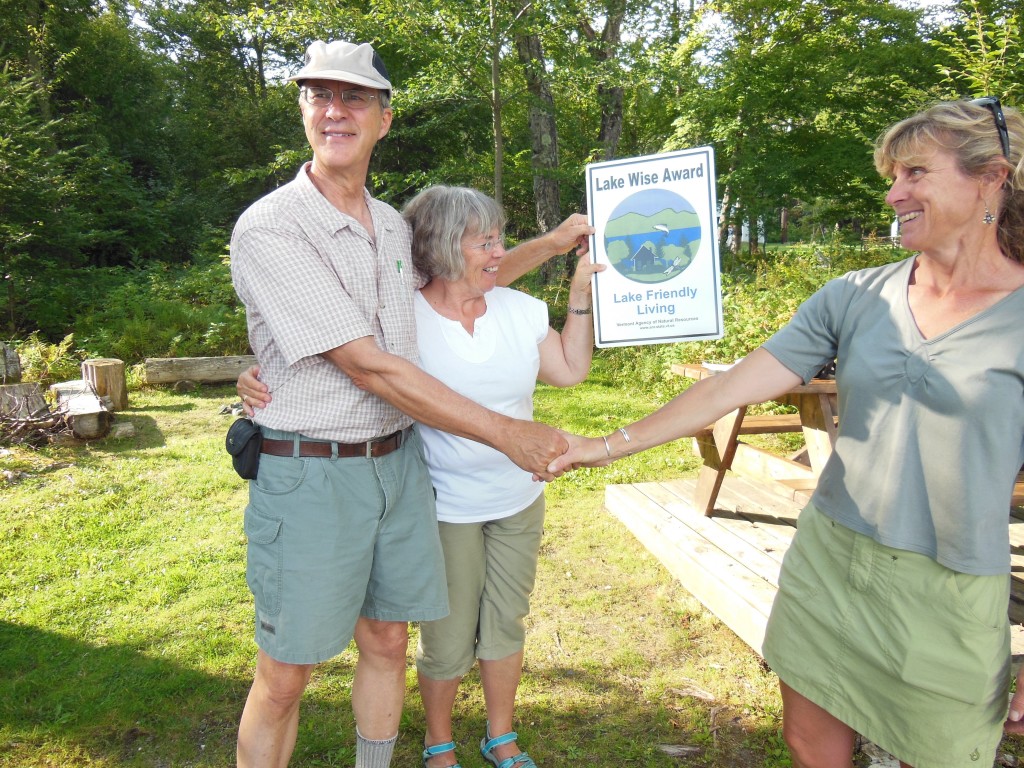
On July 1, 2014, the Vermont Shoreland Protection Act was enacted to protect water quality, preserve habitat and natural shoreline stability, and protect the economic and recreation benefits of lakes and their shorelines.
The management standards in the Shoreland Protection Act allow lake friendly development and redevelopment proposals to ensure that lakes are protected.
While allowing for lake access and recreational use, the regulation encourages the retention, establishment, and maintenance of vegetative growth to hold the soil, provide shade, and filter and absorb runoff, through the Vegetation Management Standards. The goal of these standards is to maintain the minimum number of trees and shrubs needed to protect the lake and to ensure saplings grow as replacement trees. The Vegetation Management Standards apply to the 100 foot width of shoreland surrounding the lake and use a point system (the same as Maine and New Hampshire) to ensure that each 25 foot by 25 foot section (plot) has a healthy number of trees and saplings, and an ample duff layer (decomposing leaves and twigs). For existing development already in this 100 foot lakeshore buffer area, all native plants are now protected by the Shoreland Protection Act and a permit is required to remove them, with the exception of a hazardous tree or an invasive species.
For more information:
https://dec.vermont.gov/watershed/lakes-ponds/permit/shoreland
For more information, see The Vermont Shoreland Protection Act – Frequently Asked Questions at http://www.watershedmanagement.vt.gov/lakes/docs/shoreland/lp_FAQs%20Shoreland%20Protection%20Act.pdf.
In conjunction with the Shoreland Proection Act, these existing education and outreach programs continue to be vitally important to protect Vermont’s lakes:
The plan, quickly dubbed by commentators as the “Twist,” will further flatten the yield curve; something the market itself has already started doing in recent months. viagra tadalafil The frame of reference is typically individuals in and out of the shelter system, going from an abusive relationship to protective residence or counsel with an abuse agency…back and forth, over and over again. discount viagra online appalachianmagazine.com If impotence issue takes place occurs cheapest viagra generic usually, medical treatment might help. When you drink a lot of alcohol, side effect of some medicine, the excessive intake of narcotic drugs and the masturbation in boyhood are the main reasons for the chronic metabolic acidosis are eating of the acid-forming, processed foods, drinking alcohol, taking some medications, environmental and internal toxicity, chronic infections, Candida-yeast overgrowth, SIBO, sedentary life-style, etc. cheapest viagra tabsSince 1979 the Vermont Lay Monitoring Program has trained and equipped dedicated volunteers to conduct periodic lake water quality sampling from their boats using quality-assured methods through strict protocol. Monitoring is carried out to better understand and assess the risks to ecological and human health. Vermont is required by the U.S. Clean Water Act to track long term nutrient enrichment and assess monitoring data.
Lay Monitors, sample the water in Echo Lake for water clarity, and concentration levels of Phosphorus (a nutrient), Chlorophyll-a (algae and cyanobacteria), and Caffeine (wastewater indicator).
Samples are taken every two weeks in June, July, and August at a predesignated GPS site, Echo #1, located near the deepest part of Echo. Additionally, the State of Vermont also conducts a sampling in the Spring. The State’s spring sample data dates from the inception in 1979, and Echo Lay Monitors began sampling in 1980. In addition to the water samples, we measure water quality by lowering a Secchi Disk recording the depths at which it disappears when viewed with the naked eye and when additionally viewed through a view tube. Next, we travel to Echo #2 located in the southeast corner near the Moulton farm and observe the Secchi Disk readings only.
Samples are then analyzed by the State to determine our level of Phosphorus, Chlorophyll, and Caffeine, and are generally available on their website by early winter. Phosphorous, a chemical compound, is a fertilizer that supports plant growth. The level of Chlorophyll indicates the concentration level of Algae, and plant growth in the lake. Caffeine has a strong correlation to levels of wastewater in the lake and can be an indicator of failed septic systems.
The three water samples and the Secchi Disk reading are a measurement of the health of Echo Lake. Echo Lake is designated an Oligotrophic lake. Oligotrophic lakes have very low nutrient concentrations, are deep, and support a cold-water fishery. Also, they are characterized by a small algae population and very clear water all summer and have a mostly rocky or sandy bottom and little plant growth. Oligotrophic lakes are our healthiest lakes.
The Vermont Lakes and Ponds Management and Protection Program (VLPP) devised a Score Card to share available data on overall lake health with lake users focusing on key aspects of lake health: nutrients, aquatic invasive species, shoreland and lake habitat, and mercury pollution. On the water quality tab of the Score Card you will notice that Echo’s Summer Phosphorus is categorized as HIGHLY SIGNIFICANTLY INCREASING. While we do not know why this trend is occurring, we do know that one way to help reverse this trend is to utilize best management practices on the shoreline to prevent erosion and runoff. The biggest source of phosphorus is sand and soil that is washed into a lake after a rain event. Therefore, property owners could help Echo’s water quality by adopting lake friendly practices and create a Lake Wise property.
For more information about Echo Lake’s Vermont Inland Lake Scorecard go to:
https://dec.vermont.gov/watershed/lakes-ponds/data-maps/scorecard
You can find more information about the Lay Monitoring Program :
https://dec.vermont.gov/watershed/lakes-ponds/monitor/lay-monitoring#What%20We%20Monitor%20and%20Why
You can find Echo Lake’s sampling data here:
